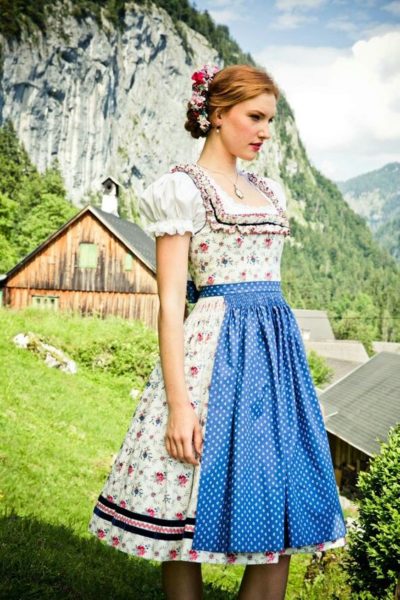
The classic folkwear dress of southern Germany and Austria is not a new one to me. The Trachten and Lederhosen are lovely ensembles with a patriotic (and varied) heritage. Yet recently I’m finding the women’s dirndl – the fashion Tracht – popping up more in my path.
Maybe it’s just me wanting to find “my style” for everyday wear.
My friend, Lauren of Wearing History had mentioned this around the first of January – wanting to have clothes that are joyful, that make her feel great in her daily dressing.
Have you been there? Tired of your closet and desiring to dress in more that makes you happy on a regular basis not just a couple times a month? Yeah, me too. (Tip: after reading this post go listen to my podcast episode on the new #historybounding theme.)
I don’t wear historical fashions often – a few times a year and including the full weekend of Costume College. I admire greatly those that dress in historical more often (weekly and daily even).

But I don’t see myself in my 1880 Vanilla Dressing Gown to chase a toddler each day. I like my corsets and petticoat but can’t bring myself to try and wear them so often.
Then last week the dirndl promptly came across my feed (or was it the brain) again.
So I googled….
OH MY GOODNESS!!
A new Pinterest board started. A deep fall down the rabbit hole. Staying up way too late ooh-ing and ahh-ing and dreaming.
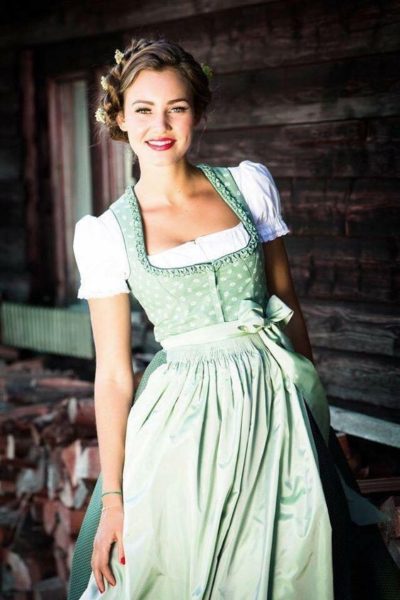
Among other sites, I landed on Gertie’s blog posts about her sudden love of dirndls in 2015 and the wearing of them. (Many from the Bavaria and Austrian areas will debate just when dirndl should be worn and when not.)
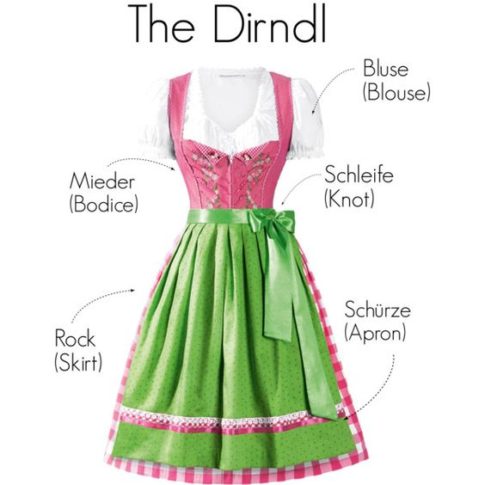
The classic dirndl ensemble is a bodice with full skirt attached – it’s basically what we call a jumper. The skirt lands somewhere just below the knee (midi) to just above the ankle. Think 1950s fashionable lengths. I’ve read the shorter length is what the younger women prefer.
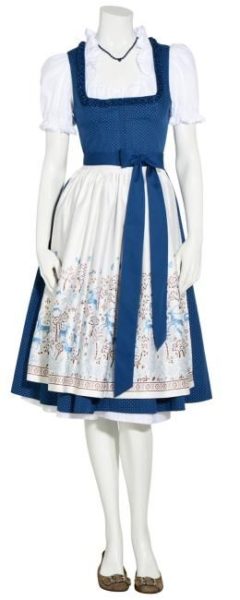
On top is a pleated apron that ties to the front or back. Those “in the know” say the apron is what sets the dirndl apart from other dresses and jumpers. The bow to the left, center and right all mean something. The back ties are for widows, waitresses, and perhaps anyone (from my research).

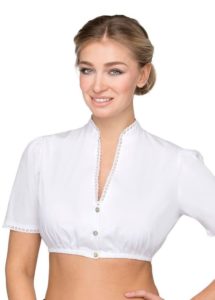
The white cropped blouse under the bodice is traditional and is short to give a smooth, fitted look around the waist. The sleeves are generally short but really can be most anything in a modern dirndl. There’s short straight, short puffed (with varying degrees of puffiness), elbow length with or without flared cuff, and long to the wrist.
I’m told the blouse is usually white, but you’ll see black in the Alpine areas. I’ve even seen some modern blouses in prints.
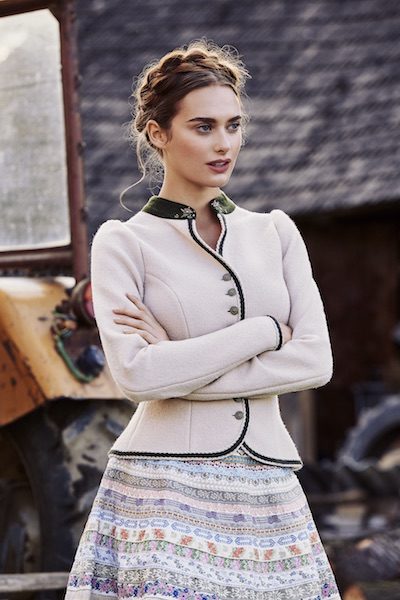
Jackets in wool are common for cooler weather. Adorable, practical and comfy in single breasted with round or shallow-V neck line. (I’ve even come across some of these jackets in knitted form… oh dear. Time to combine my obsessions.)
The front of the low-cut bodices can be closed with buttons, lacing, invisible zipper or decorative lacing over a zip.
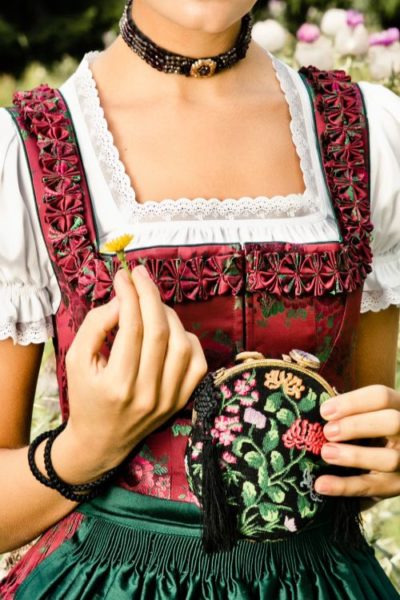
So, after more than a few hours of scanning dozens of images and getting more inspired with each one, I’ve decided why the dirndl style calls to me so strongly. Maybe some of these traits will resonate with you – as fellow historical costumers – and you find yourself drawn to the dirndl style.
Why the Love of Dirndls (not in any particular order of greatness):
- Fitted bodice. This comes from our love of fitted Victorian bodices. And the dirndl bodice is/can be made with a flatlined lining and even boning. Hello Victorian!!
- Full, swishy skirt. Is there anything as fun as a skirt that you can twirl in? To feel romantic in? To feel girl-y in?
- Let’s talk fabrics – YES! My heart bursts with joy at floral prints and color and IN COTTON. Hello! I’m the Cotton Girl, are you one? And the small prints and the stripes and the plaids and, and, and…… And you can combine them into beautiful ensembles!! No choosing just one but THREE (plus one for the lining if you wish) to make your heart happy.
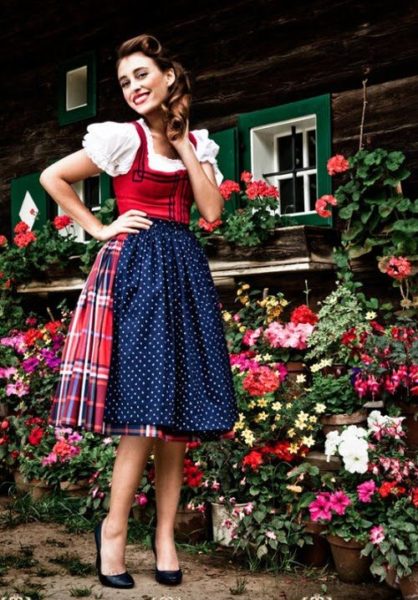
- Linen and Wool and Silk are all a-ok to use too – huzzah! Does this make your historical heart sing? I mean, all four natural fibers are used and appropriate for the dirndl. Yes!
- Apron with puffy bow. Feminine, not sexist. AND… the top of the apron is gauged or cartridge pleated with up to eight rows of stitches. Wonderful!
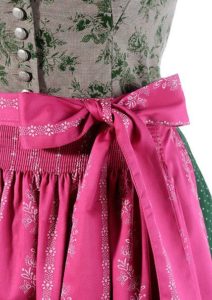
- Puffed sleeves on the blouse – Anne Shirley would swoon to have them. “Marilla, look at the puffs!”
- Lace and braid and trim of various kinds around the skirt hem and on the sleeves and neckline. TRIM!
- Pleated trim around the bodice neckline is very common in the traditional look. Pleated trim like the one in my tutorial here. Bring your love of Victorian trimming into your dirndl.
- Metal buttons – not unlike 19th century ones. Snag those 1880s designs and put them on the dirndl bodice.
You can see why if you love Victorian you might like dirndls. I’ve fallen HARD and plan on making several for my every day wardrobe. They’ll go wonderfully with my many American Duchess shoes. Break out those Gibsons (my favorite)!

In the midst of all this whirlwind research in the last couple of days a gracious Facebook follower posted a link to a group all about dirndl sewing. My tribe! And…. They are even working on a #DirndlChallenge of sewing one up from February thru June 2018. If interested, this is the group.
I’ll post more resources later on fabrics, patterns, designs, wearing, etc. It would be lovely to have you join me in this new obsession journey. Let’s learn and sew together!
I first shared the start of my fascination last week in a Live Facebook video. Enjoy!


Sadly Stoffcity does not shiptousa anymore. Sad.
A lot has closed re: shipping from EU due to Covid – ugh. Hope it comes back soon! AND… maybe if they get enough inquiries they may consider shipping to USA again.
I’m two years late for this post, but when you say people who love the dirndl do so because of a love for victorian fashion I have to protest 🙂
I love the dirndl. I would love to own one and have time to wear it. On the other hand I find victorian fashion off-putting. Fashion from the 1830s until the 1920s just do not spark joy in me. My joy for it can only be secondhand since I do find some joy in watching other people enjoy it, but for me personally it is just drab.
Thanks for your comment, Outo! Since most of my readers and students love Victorian fashion and the sewing of it, I wanted to compare that dirndl construction reflects 19th century sewing in a few aspects – a great way for someone to transition from sewing historical styles to the modern dirndl. 🙂
Funny thing, I finished putting my own dirndl together this spring, and just found this post today! For me, it’s a part of my heritage (and I actually lived there as a kid) and my community does a few German/Ethnic heritage things each year, so I’ve been piecing together my outfit from things brought over that hadn’t fit for years (or Mom hadn’t gotten around to sewing…it’s hereditary). I have a black wool skirt with deep red roses on it, a separate (working the historical angle) black bodice with red binding, and white blouse and apron, and keep getting asked if it’s Dutch. Oh, well; cotton might work better for summer here anyway, and who doesn’t love making another outfit, right? The moment when you’ve finished your hair and put on the last accessory, tug the bodice just a tad, and look in the mirror and feel RIGHT, is worth all the time spent on research and ripping out seams.
I’d never heard (or forgot) about the bow placement meaning anything, until starting my online research this year, but one website included a comment from a clerk in a dirndl store in Germany. She said it’s only been in recent years that the store owner told the staff to tell customers about the “meaning”, and that they should make it sound like their sharing a deep secret, so maybe it means nothing…The one time I got to Hawaii, the tour guide said something very similar about where a lady places the flower in her hair. I’m pretty sure my mom tied my apron in the back when I was small, so that I’d be less likely to untie it myself (and lose it somewhere).
I have dirndls from 54 years ago. I used to do International folk dancing and each of us that performed had to research and make our own costumes; sometimes we could purchase them from someone going to Germany, but most of the time we had to make our own. The dirndl is one of my favorite costumes, maybe it’s part of my heritage. It is comfortable if it fits you properly. I love the sound of music and was able to make the costumes for the play. I have to omit I didn’t have the time to make the apron appropriately but I only had 4 weeks to make all the costumes and it was a huge cast I did have some dirndls from Germany that were used and a couple of my own. I was very proud of that play. Even lederhosen was made. I’m very glad to see people who are willing to bring back the German dirndl. My research from many a year ago has prompted me to go back and make some of my original costuming to fit myself now. Put on too much weight for my old ones. HAPPY Dirndling.
Yay! I was recently gifted a vintage dirndl – beautiful embroidered purple linen – which I’ll be altering to wear. They are indeed quite comfy and beautiful. 🙂
Sorry I’m late to the party. I went through a dirndl obsession too, a few years ago, when looking for a way to incorporate my love of historical fashion. I remember learning during my research at that time that because the dirndl skirt is not usually *quite* as full as many historical skirts, that the apron was necessary to cover the placket gap on the front opening. I suppose you could just continue your fastenings all the way down from the bodice though 🙂
How fun you did this too! And yeah…. found out that the apron is VERY important that way. I had taken it off after my first event wearing and looked down (was in the car at the time) and -hello!- Yeah. Ack! But in my research I don’t think the skirt opening has any closures traditionally.
So you’ve inspired me, and I’m working on a dirndl to wear to an event in a park in a few weeks. It’s coming out pretty well, but my skirt needs some extra poof. I know I need a petticoat to give me more volume,but it’s liable to be hot, so I want to stick with cotton. Would a muslin petticoat with a few tiers of ruffles hold up and give me a nice bell shape? The skirt is just barely calf length, and made of a light cotton print.
Also, thank you for this website, it was such a help when I was working on my first Victorian dress last fall.
Hi Sarah – thanks so much for reading and letting me know the articles have been helpful. And yay for dirndl sewing!! For myself I’m pretty hip-y and tried on a basic net petticoat I made for another outfit but it didn’t sit right under my dirndl skirt. I’ll be making a simple cotton petticoat with perhaps one deep ruffle along the bottom. But you can certainly make yours with more ruffles. Just be careful and not go too crazy with overall petticoat width unless you want a vintage/1950s type of look. I’ve also thought to make some short drawers (closed crotch but similar to Victorian drawers) to wear under my dirndls. Definitely use cotton. Starch it if you need more “oomph” under your skirt. Happy sewing!
My petticoat is a thin cotton, maybe voile or batiste, and has only one ruffle of 5 inch eyelet at the hem. I wear it with my wool dirndl every June for an event in 90 degree heat, but this year it was over 100! and I was fine. The petti had an okay fullness under my wool skirt (which is flowy but a little heavy, as to be expected). However, it was way too long, about 4 inches showing below the wool, so I decided to put some tucks above the ruffle. This put the eyelet showing just a half-inch below my skirt (since it’s black, I wanted some contrast), but it also gave the petticoat a lot more body, and now my skirt looks so much fuller. For dirndls, the silhouette is closer to 1950’s than bell-shaped, so petti ruffles are typically kept close to the hem, although if you’re thinking of a 1930’s-40’s look, you can skip the petti ruffles completely. Like Jen, nature gave me plenty of built-in shape in the hips, but for someone very slim-hipped, a yoke or a higher flounce can help.
May have to go rooting through my stash and make one for daughter (she’s 11 and been loving the pinterest pictures) and myself. Wonder if I could convince her that her curtains should be an apron…
Fun! And yes – curtains are perfect. 😉 Have fun making both dirndls!
Years ago I made 2 dirndls to wear when I went folk dancing, inspired by a member of my dance club who had bought a dirndl when on vacation in Germany.
I used Burda 8448 and Burda 8395. The latter had an apron with gathers. With the former, I did the cartridge pleating and made the skimpy blouse.
I prefer conservative colors and might have made both skirt and bodice of plain colored cotton. But something moved me, thankfully, to make both skirts of printed fabric with very small flowers. The bodices are plain, one black and one dark forest green. The background colors of the skirt prints match the bodices.
They are so comfortable and pleasant to wear. I’m now inspired to wear one the next time I go to some event. Thanks, Jennifer.
Fabulous! And good call on the small floral print for the skirt.
I’m using Burda 8448 for my first dirndl and will cartridge pleat the skirt and apron. Glad to know the blouse is skimpy. I’ll be making it up simply just to have one to get started wearing the dirndl dresses. I’ve got a Victorian walk-about coming up and will be wearing my first dirndl there. Any excuse! 🙂
Hi Jennifer!
Your dirndl obsession comes at a perfect time for me…I want to make a new dress for our annual Dicken’s Fair in San Francisco, and bought a fun, trachten style hat as my inspiration. I hope to create a dirndl/dickens era hybrid outfit. No, not historically accurate but it will be fun!
I’m eagerly awaiting my copy of “The Art of Manipulating Fabric”. Hoping to debut this at Costume College in July.
Thanks for all your beautiful work and inspiration!
Laurel
Yay! And you’ll love that book.
I’ll be wearing my dirndl on Friday or Saturday of Costume College this year. Come find me! 🙂
And if you look into the Swiss folks costumes, you get even more choices: differing skirt lengths, even more blouse options, vests that span the historical patterns from 1600 to the 19th century, jackets that look deceptively like Victorian riding jackets, etc. For the winter, skirts in wool, too. Metal buttons, chains, embroidery, filigree jewelry – all kinds of nifty stuff. And the best are the hats – but that is not something that is wearable in our day and age…
Oh, ok! Thank you. I’m loving the charm jewelry.
And I think the hats are wonderful! Yes, they are a little “out of place” for everyday wear, but one could wear a alpine hat and be extra classy. 😉
Hello Jennifer,
I am making my first bustle dress! A black taffeta dress from 1870 but am at a loss about how many petticoats to wear and what types? Ruffled, plain…?? How many and what styles?
I referred to your what bustle to wear for what part of the bustle era and think that I am going to use Truly Victorian 163 in regular if that helps!
Thank you so much for your wonderful site, it is such a gift to the historical dressmaking community, I would not be able to do anything without you!😀
If you’re doing early 1870s over a lobster tail bustle then I’d recommend two petticoats. One can have ruffles down the back with another on top to smooth out. Take a look at this post too:
Hello Jennifer,
I am planning on recreating a red tailored dress from 1900 but am at a lose for what corset to make to wear underneath for the perfect silhouette? S-bend corsets seem to be an Edwardian craze but I think it would look odd with a dress from the year 1900 since the entire “pigeon breast” style was not in full effect. Anything earlier though might look weird too? What type of corset should I wear? I’m very new to Edwardian sewing as I have mainly only done 18th century until now!
Best, Drinda
There’s a couple ways to look at this. The Truly Victorian TV110 is based on a 1880s silhouette that can be used quite well for the very late Victorian years – up to 1900. This is backwards looking, yet most women then were still wearing that style of corset even as the fashion was changing to the pigeon front look. Then there is the Truly Victorian TVE01 corset dated to 1903 with bust and hip gussets. I’d personally go with this and not put a lot of padding in the hips and bust as would come in a couple years with the S-bend. The TVE01 is comfortable and will take you through the first decade of the 1900s. If you would be doing more Victorian then go with the 110. If you plan on more Edwardian sewing then I’d recommend the E01. (Links are to my online shop.) Cheers!
7084 falls under the Tracht category – also known as Landhaus fashion or “traditional dress” – so not a Dirndl per say but it falls under the same category in Germany and Austria (also Switzerland)
The Gertie Dress might also fall into the landhaus category but her skirt is super full, so i am not sure.
There are so many fabulous Dirndl vendors in Germany, Austria and the USA – Christine already mentioned RareDirndl – who is fabulous and local and she does custom.
So excited to welcome you to the fun of dirndls – I have several including a Wonder WOman Dirndl 🙂
Thank you! And how fun on the Wonder Woman dirndl?! I think the basic cut and shaping lends itself well to all sort of creative works. And thanks for the info on the patterns. To me, Gertie’s looks very mid-20th century vintage looking, but that is her style, too.
My best friend, pin-up model Pamela Marie, made us couture dirndls last summer. They were amazing! She even made the trim by hand and custom fit them to us using our Elizabethan corset patterns. IG Photo
How wonderful! They are lovely.
Hi Jennifer,
great post and valuable information you gathered here! It’s cool how you draw the line from Victorian Costumes making to the dirndl, actually never realized it until now! Also great that you talked about tying the bow properly, I think that is a fun fact and living in Munich, I can confirm that many people still look at the way the bow is tied!
There is also a modern twist to the apron coming up the last few years, to have no bow but just close it with a buckle (german: Schnalle). I love it, it looks very pretty too and I think it is also great when wearing a jacket over the dirndl (as the bow sometimes makes a strange mark below the jacket).
Talking about the length of the dirndl, actually the Midi size (knee lenght) is the shortest someone should go (even younger women). Everything shorter than this, so Mini and also the carnival dirndls are not really considered dirndl in the opinion of many people living here in Bavaria. When I moved to Munich from another city in Germany I had one Mini Dirndl from a larger German warehouse and had to get a new one, to be allowed to work in a Bavarian restaurant as a waitress 😉 But sure, girls at the age of 5 or 6 also were the Mini ones 🙂
If you have any questions considering Dirndl and “Tracht”, reach out in the Facebook group, we all happy to help 🙂
Best regards from Munich,
Vivian
Hello Vivian! Thanks for the comment. What a great idea with the apron buckle for fastening! I love the jackets for winter and can see how the buckle would work well.
I agree with the short – above the knee mini length. It would be a “costume” thing here in the US too. That length just below the knee is so flattering and perfect.
Looking forward to all the connections in the Facebook group! 🙂
Thank you for mentioning my website MyDirndl.com. Since starting the website in 2005, dirndl, lederhosen and “Trracht” have become pure joy to my spirit. It’s my heritage, and, heck, it’s just fun.
Head Dirndl Frau
You are welcome. Honestly I was scouring the ‘net for inspiration for blouses and yours came up. I was excited to see a US supplier – huzzah! Cheers! ~Jennifer
Love Dirndls <3 I own about 20 – some vintage and some I have made. It's so fun all the different combinations you can make. Plus you can make a winter style, a dress style, or summer style. So many choices. I've made so may of the burda patterns and the folkwear pattern (I've made the Burda one you have 3 times) – plus I have a few vintage patterns. Also check out Rare Dirndl – Erica Neumayer's designs are great and she's here in the USA. It's definitely an obsession for me.
And I made the Burda one that is a dress type to recreate a Lena Hoschek design three years ago. I’ve changed that blouse pattern to make it button also and added different sleeves. And the Burda Patterns for kids are great – I’ve made a few for my nieces.
I love dirndls! Before I put on this last bit of weight I wore dirndls ALL THE TIME 🙂 Worn without the apron and they make great everyday wear. I get so many compliments when I wear them. Personally, I think it’s a style lots of different sized/shaped ladies can wear. My husband loves them too because they give a very feminine shape. I usually use the Folkwear dirndl pattern, but Burda is usually pretty good.
That’s my plan! And yes, well suited to the women’s figure. I’ll probably get the Folkwear pattern even though I’ll have to grade up a bit on it. It has such good reviews.
These are amazing! I am the first one to snap up the floral cotton prints on sale to make blouses from. That is so interesting about where the bow is tied. I also didn’t realize these waistbands are cartridge pleated! I can see why you are fascinated by these. Very cute. And the little jacket is wonderful. I can’t wait to see your color/print combos. HAVE FUN!
I agree with all of this! I always used to wear 50s repro for every day (that I made of course!) But don’t fit in my collection anymore and can’t nurse in them. The dirndl can be perfect for nursing with a zip front and the elastic at the bottom of the blouse. I already wear aprons so much and I’m excited to make a collection! Not enough hours in the day.
I agree with the lack of time! And thank you SO MUCH for sharing the group and other info with me. 🙂
I recognize a lot of the attraction you write about! My daily style is somewhat influenced by the classic lolita movement (toned down a bit), but it has practically the same attractions. Full skirts, good quality fabrics and fitted tops. It’s fun to see how to incorporate some ‘historical’ aesthetics into modern dress!
I saw a documentary on the dirndl and lederhosen a while back, which talks about how they came into existence. I particular found it interesting how they didn’t really evolve from any type of clothing worn daily, as practically any other traditional costume I know of. Instead they were almost ‘invented’ at some point to serve as a national identity thing, and everything sprung from there. (That also makes me a bit skeptical about the ‘meaning’ of the apron bow, as the clothing was never worn daily, I don’t know how those things would’ve evolved, or if someone just made up a ‘rule’).
Anyway, I’m afraid it’s only in German without subtitles, but the whole thing can be found here.
Good luck on your sewing!
I agree, from my research, that it evolved out of the traditional dress into a “national identity” look (love your phrase here). With all the similarities with Victorian construction that we love it’s a great way to incorporate them in to our daily wardrobe. You are so right. And thanks for the video link. I took German in college…. time to refresh!
You need to search for fuchsdeifiswuid on instagram their dirndls are just beautiful.
And if you love to sew boning search for steifes mieder.
Oh, thanks!